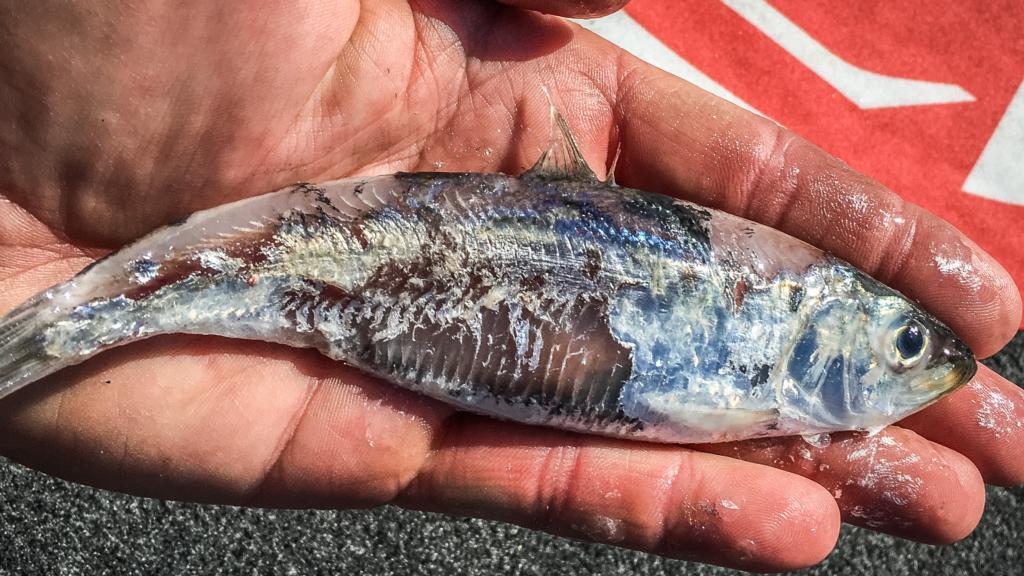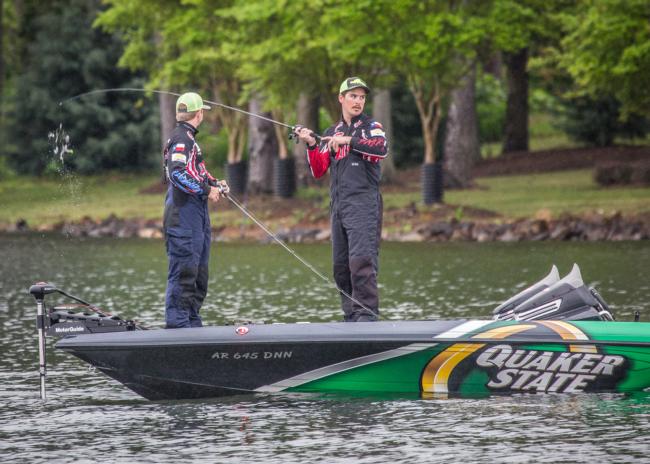Spring Strategies for Blueback Fisheries
Chasing a blueback herring bite can be really right and really wrong

Blueback herring have a reputation as finicky baitfish to keep track of, but they’re among the most important forage species in most lakes they inhabit. Making the right call between chasing a herring bite or fishing traditional patterns can make or break a tournament.
With the FLW College Fishing National Championship coming up on Lake Keowee and the Walmart FLW Tour at Lake Hartwell, both blueback herring lakes, now is the perfect time to go in-depth on this unique baitfish.
About bluebacks
Blueback herring are anadromous fish like shad, so they naturally run from the ocean into freshwater rivers to spawn, though that behavior is curtailed in lakes and reservoirs where they’ve been introduced. Blueback herring are pretty widely distributed, and have been found as far north as Lake Champlain and in parts of the Tennessee River and elsewhere throughout the South. By far, herring are most common and influential to bass fishing in the Mid-Atlantic region, particularly in the Carolinas and Georgia.
Slimmer than shad, herring spend the majority of their lives suspended and roaming open water, and the bass that relate to them have a reputation for being very nomadic and on again, off again. Despite their tendency to roam, herring do have some general seasonal movements that anglers can take advantage of.
Winter and prespawn
Prior to the bass spawn during the winter and prespawn months is one of the more stable times to key on bass feeding on herring. It also lines up perfectly with a number of big tournament wins, particularly Brent Ehrler’s Walmart FLW Tour win on Hartwell in early March 2012 and Casey Ashley’s Bassmaster Classic win on the same lake in Feb. 2015.
“The bluebacks stay down with the stripers all winter, and then they start moving up the rivers and creeks as the water warms up a little bit,” says FLW Tour sophomore Jason Johnson, who’s spent countless hours studying herring on Lake Lanier.
Per Johnson, the bass in Lanier make the switch from eating threadfin shad to eating blueback herring sometime in the late winter. He speculates that the switch has something to do with the metabolism of the bass and their ability to catch the herring.
It’s fairly common knowledge that the bass keying on herring tend to top out at about 5 pounds. Bigger bass supposedly can’t – or won’t – chase down the fast-moving baitfish. Johnson believes that, regardless of size, most bass in cold water face the same handicap and can’t catch bluebacks until the water warms.
One day, the bass will be chewing small swimbaits that imitate threadfin shad, and the next, they won’t touch anything but a 5-inch swimbait that matches a blueback. Though the transition isn’t always as profound as Johnson describes, it goes a long way toward showing how desirable herring are as a forage species.
Prior to the bass spawn, there are two primary places to key in on herring eaters: offshore funnels and feeding pockets.
Offshore funnels
One of the most reliable ways to catch bass that are eating herring is to focus on places that herring will move through and across on their way to and from the main channel and shallower structure.
When Ehrler won at Hartwell in 2012, he targeted several flat points and saddles along islands situated in between the main lake and shallower creeks. Herring moved back and forth through his areas.
“When they get in a place like where Ehrler won, that is like a herring funnel,” explains FLW Tour pro Brandon Cobb, who is a favorite in any tournament on Hartwell. “It’s a drain, but it isn’t in a pocket. Those herring move through there, and the bass sit in it like an ambush point. So, those were herring fish, but they were more consistent because they were waiting on the herring, not following them.”
Finding an offshore spot, be it a point, saddle or hump, that herring need to move over frequently to go from the main channel to the pockets can be money. Once you’ve found a spot that holds bass, you can often fish it pretty conventionally.
“An under-spin has been one of the best baits for years on Hartwell,” says Cobb. “I don’t quite understand why it works so well because it is drastically smaller than a herring, but it’s one of the best. But, those offshore fish will bite a jig or a drop-shot too. It’s not like you just have to match a herring to catch them. The main time when you have to just match a herring is when the herring are up spawning on points.”
Feeding pockets
As spring wears on toward the spawn, the herring increasingly take low-light (usually nightly) trips to pockets off the main lake and bigger creeks. A pocket that is full of herring and bass can be a beautiful sight on tournament day.
“That bite happens first thing in the morning,” details Jayme Rampey, a third-year FLW Tour pro who also specializes in figuring out herring fisheries. “The herring will pull up in those places with the warmer water. They’ll be up in the pockets for the first hour of daylight, and then they’ll back out into the timber again. Before they spawn, they’ll be right in the back.
“They’re not hard places to find, but the herring absolutely vanish when the sun comes out and they go out and suspend in the timber. They’ll do that for a good three or four weeks before the herring spawn. That’s when you catch bass up shallow in the prespawn.”
Cobb and Rampey agree that finding pockets off the bigger channels isn’t the challenge. Bass hitting the surface and loons grouped around the mouths of productive spots are easy signs. The challenge is in making the most of it on tournament day.
“The thing about herring is they’re here today, gone tomorrow,” says Rampey. “You can be on the biggest bag of fish you’ve ever been on Friday, and you don’t get a bite Saturday.”
Targeting herring in pockets isn’t limited to the Carolinas. In 2015 at Lewis Smith Lake, Rampey managed to get on a pocket-based herring bite in practice, focusing on the plentiful coves just off the steep and winding main channel. As the bass headed to the beds during the tournament that pattern fell apart. Luckily for Rampey, he had other cards up his sleeve and still managed to finish 16th on the north Alabama reservoir.
If you do happen upon a cove with the juice, actually catching the bass usually isn’t too hard. You can wait and throw to breaking bass, cast a walking topwater or work them with a jerkbait. If the fish are a little more fickle, a swimbait, drop-shot or shaky head are good ways to go.
The spawn
When the water temperature begins to get into the low to mid-60s the blueback herring typically begin their spawn. Usually, it aligns with the back end of the bass spawn, but that isn’t a hard-and-fast rule.
“Generally after the bass spawn they spend a few days up shallow, and then the herring spawn starts and the bass follow them up on the points,” says Cobb. “If it gets real warm real quick, you can get a herring spawn and a bass spawn at the same time.”
During the herring spawn, the classic clay point is a favorite target of anglers, but it isn’t the only place to search.
“As herring are staging up before the spawn, really good places are any kind of shallow saddle between islands or sandy blow-throughs,” expands Johnson. “Instead of being right up against a bank they seem to like to have water moving through where they are spawning. They really like a little funneled-up current for some reason. A really simple way to find bluebacks is to go to those high-percentage areas and throw a double-willow spinnerbait, and you’ll feel them hitting on the blade like they’re trying to spawn with it.”
Even when it comes down to running long clay points, Rampey cautions against getting too narrow-minded. While he admits that herring love main-lake points, he says he often searches for points with herring in the creeks, where the bass might be less pressured.
On a good point, the bass will often be dirt shallow, sometimes easily visible roaming in inches of water as they wait for a group of herring to move up on the point before jumping into action.
Matching the herring closely with a swimbait, umbrella rig, soft jerkbait or topwater can be important, but the fish will sometimes get so finicky that the only way to catch them is with a shaky-head worm. Regardless, stealth and surprise are usually paramount when the bass are super shallow and actively feeding and when herring are in the mix.
Getting burnt
Though blueback herring are often a prime factor in tournaments where they are present, resisting the temptation to chase ghosts can be a smart call as well. In 2014 when the FLW Tour stopped at Hartwell, Ashley picked up the win targeting bass in brush that were simply in a prespawn pattern, not heavily relating to herring. Additionally, Andy Morgan, Clent Davis and John Cox all made the top five by staying away from herring.
This week, with the water warming and a lot on the line in the second event of the FLW Tour season and at the FLW College Fishing National Championship, we’re sure to see herring play in some fashion.


